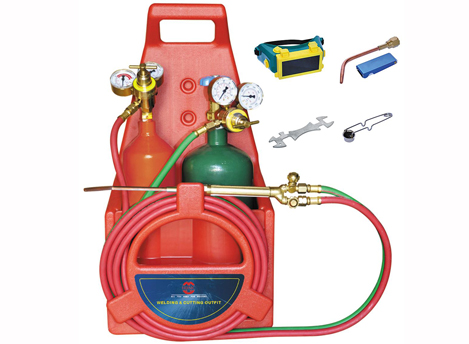A cutting torch is found in all types of shops and on construction sites. There is always a need for cutting metal and a torch is very handy for many types of cutting jobs.
And the better you learn to handle the torch the more versatile it will be. This article covers the standard type of cutting torch which is an acetylene torch set up.
Pure oxygen is used for the cutting jet and it's mixed with either acetylene, propane, or commercial gas to provide the preheat flames.
An oxy acetylene mixture burns the hottest, somewhere around 5800 degrees, and that's what welding cutting kit supplier will be about: the acetylene cutting torch.
Propane is not as expensive as acetylene and so many people gravitate to this type of fuel. Oxypropane burns around 5300 degrees, which is plenty hot, but the rate of burn is smaller. So it takes just a little longer to preheat before a cut. Either oxyacetylene or oxypropane works well for torch cutting. The portable welding cutting kit contains all the quality equipment needed to cut, weld and braze in a sturdy plastic carrying case.

Oxidation and Cutting Metal:
A chemical reaction occurs when oxygen contacts metal. This chemical reaction is called oxidation and rust is the result of the process of oxidation.
As you heat metal to about 1800 degrees oxygen gets in contact with your metal and you then create combustion or rapid oxidation.
A cutting torch does the same kind of thing. It basically burns your metal and produces slag which results from iron oxide that is created as your torch burns the metal.
Why are you able to cut cleanly through carbon steel?
Well, the oxides that are created as you heat and cut your metal melt at lower levels than the actual metal itself and since the cutting torch has such force it is actually is forcing the molten material (oxides) through before the metal actually melts.
Conversely it's more difficult to make a clean cut on aluminum, stainless steel, and cast iron because the oxides that you create as burn have a higher melting point than the actual metal you are cutting. In other words, the metal is being melted before the oxides can be forced through as you cut.
Cutting Torch Safety Tips:
Before we move on to more interesting stuff here are a few tips on acetylene cutting torch safety:
You need to pay attention to what's going on around you, and try to anticipate what will happen as a result of what you do.
Cutting torches are so hot that they can to burn almost anything so be careful where you are aiming it when it's lit.
The slag alone can start a fire so keep your work area really clean.
Keep anything flammable far away from your cutting area. This includes but is not limited to: solvents, paints, fuel, etc.
If there are any rags, saw dust or paper in your work area be sure they are not smoldering because it's hard to notice it at first. So keep an eye out for things like this.
Make sure you have a fire extinguisher that can handle any type of fire, and make sure you know how to work it.
Do not wear clothing made of synthetic material, or frayed clothing. If synthetic clothing catches fire it will melt your skin.
Wear a good set of boots, and safety glasses.






